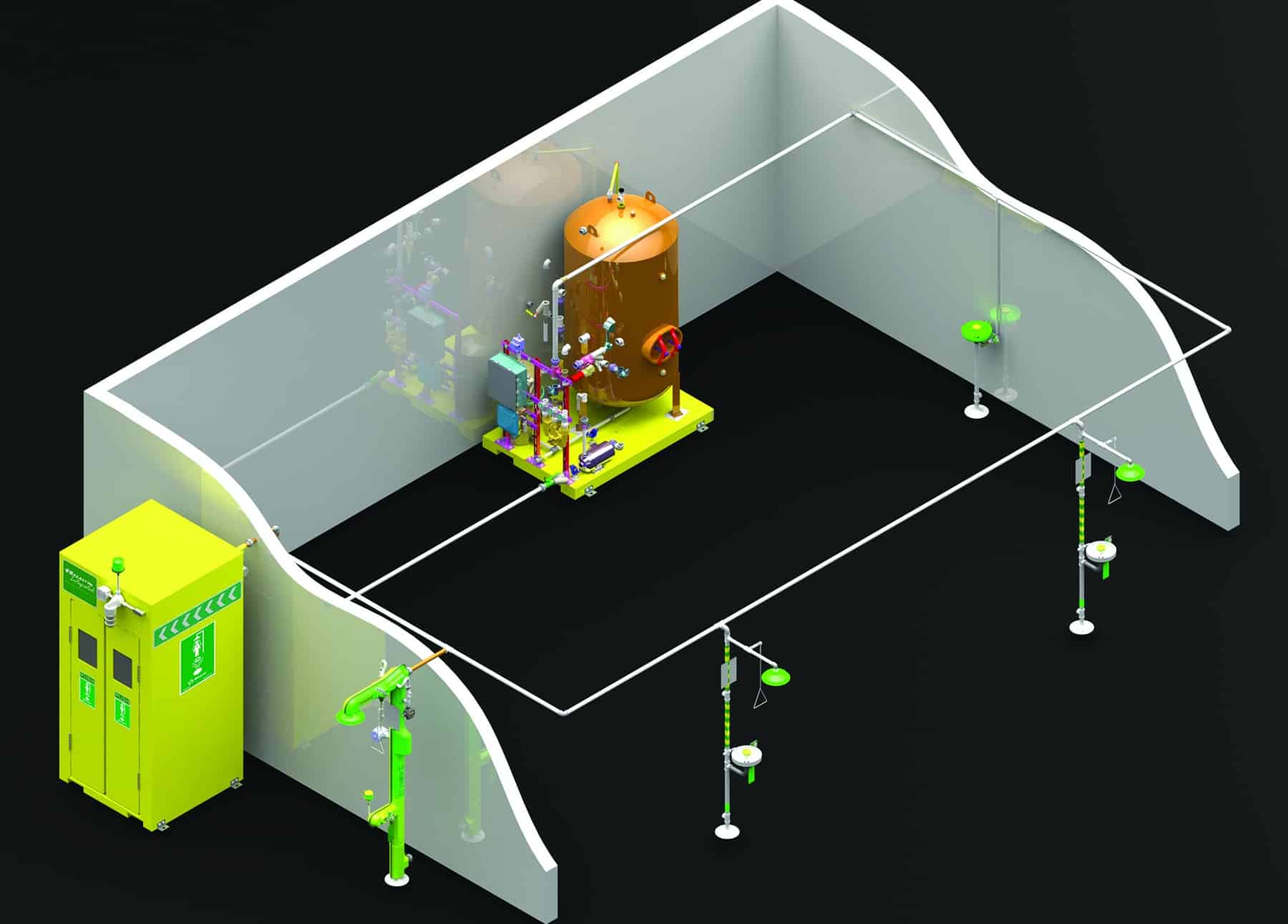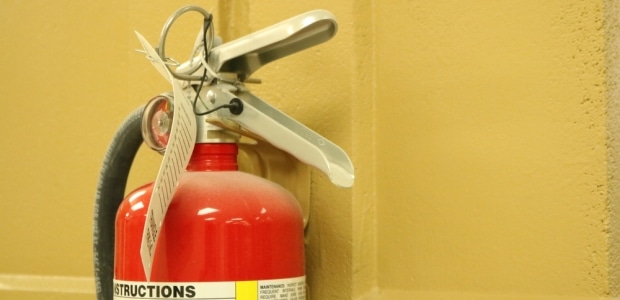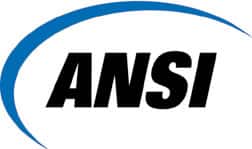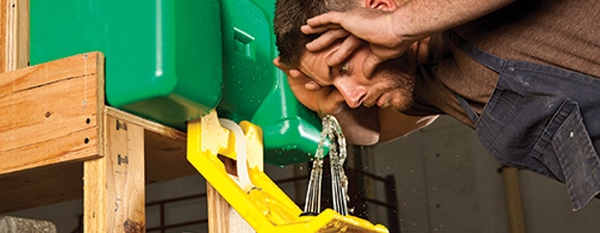[via OH&S Magazine May 2018 Issue]
Creating a “Comfort Zone” for Emergency Equipment Water Temperature
By: Samantha Hoch, Product Marketing Specialist at Haws®
Tempered water has been a hot topic of late, but just as many installations need cooling of high-temperature supply water.
Moving water transfers heat, either increasing the temperatures of the objects it contacts or decreasing them. Heat transfer, via moving water, made twentieth century man more productive and more comfortable. It sped up transportation and made a wealth of innovative products possible. But, while the physical properties of heat transfer via water movement can certainly be beneficial, there are many instances when temperatures must be controlled within a high and low range to avoid injury. For many years, industrial emergency equipment was not one of those instances. The water that flowed through emergency showers and eyewashes were subject to climatic, source affected and other ambient variables that could raise it to injurious temperatures or lower it to downright freezing temperatures.
Municipally supplied water, when running for a sustained period, tends to cool down or even heat up, eventually approaching its source point temperature. And, by the same token, water subjected to hot or cold ambient temperatures in manufacturing plants or elsewhere can become dangerously hot or cold. Presently, OSHA – 29CFR 1910.151(c) – requires the availability of suitable first aid treatment facilities. Specific direction is given indicating that “suitable facilities for quick drenching or flushing of the eyes and body shall be provided”.
While the definition of “suitable” was mostly left up to the specifier in the past, the current ANSI/ISEA Z358.1-2014 Standard provides much greater clarity. ANSI mandates a water delivery temperature range defined as “tepid”. This is clarified as a 40-degree temperature range for flushing fluids spanning from 60°F to 100°F [16°C to 38°C]. Yet, no source information proves that 60°F for 15 minutes in potentially freezing outdoor conditions will not lead to hypothermia. Nor is there supporting documentation to verify that 100°F would not scald or further injure the delicate eye tissues or skin.
The thought of an injured worker short-cutting the required emergency equipment use cycle because the water is too cold or hot has led to the notion of the “Comfort Zone”- a revised outlet water temperature range that assures comfortable, non-injurious use for the full 15-minute use cycle.
Revisions to the ANSI/ISEA Z358.1 Standard have occurred on a somewhat routine basis. Published in 1981, the standard was updated in 1990, 1998, 2004, 2009 and most recently in 2014 with the expectation of another update on the horizon. It is suggested that a revised water temperature range between 70°F and 95°F can help ensure medically effective results and provide that best practice comfort zone. Increasing the minimum flushing fluid temperature to 70°F can encourage users to use the equipment for the full fifteen-minute flush cycle, protect against cold shock that could lead to cardiac arrest, and advocate for the removal of contaminated clothing. Decreasing the maximum temperature to 95° F will help avoid temperatures known to harbor specific bacteria growth, prevent scalding of the eyes and skin, and reduce the chances of an increased chemical reaction.

So, how do you ensure a facility’s equipment falls within the comfort zone? For the sake of this discussion, we will assume that the plant has sufficient emergency equipment in the appropriate locations and that the comfort zone approach is being added to the existing emergency equipment assets.
Let’s consider the most appropriate steps to be taken:
- Ascertain your actual inlet water temperature range and compare it to the desired range – This involves checking the initial and sustained temperature readings at the various emergency equipment sites located throughout the facility. Since conditions can change from location to location, the chore of checking each shower and eyewash is the safest bet. Don’t forget the impact of seasonality on water temperatures. It may be necessary to check at several times during the year.
- Determine the overall changes needed – If initial temperatures are either too hot or too cold, while sustained temperatures are within the ANSI mandated temperature range or even the recommended comfort zone, consideration of a re-circulation system is appropriate.
If sustained use temperatures fall outside of the temperature parameters, you may require warming technologies, cooling technologies or in certain areas and circumstances, both. In most instances, these types of systems can be sized to handle multiple showers/eyewashes each. Specific applications should take into account the volume of shower and eyewash locations to be included in each loop, the maximum distance between components and the impact of exposure of warmed or cooled pipes to ambient air temperatures. It is highly recommended that specifiers work with eyewash and shower manufacturers directly to determine the appropriate system, given your specific geographic location, processes, temperatures, and layout/equipment locations.
It should also be noted that while tempered water – meaning warming cold water – has been a hot topic of late, just as many installations need cooling of high temperature supply water. Elevated temperatures can come from several sources, including high ambient temperatures, exposure to process heat or excessively high supply temperatures.
- Identify the number, required location(s) and sizing of the thermostatic mixing valve(s) – This applies only to tempering water or warming sustained use cold input water prior to emergency equipment use.
The brain of a warming system is its thermostatic mixing valve. This device ensures that the safety equipment safely receives water at the required temperature. A good thermostatic mixing valve is actually a system of valves, typically designed by safety equipment manufacturers since they understand their equipment and their specific flow rate requirements. Specifiers are cautioned to do their homework well with respect to selection of the proper valves for your specific needs.
- Determine your hot and/or cold water source – In sizing the tempered water system for any particular application, providing a source for sufficient quantities of water is essential. Recent advancements in instantaneous hot water heaters have made these products practical for use in emergency equipment applications, especially where space for traditional hot water heaters and hot water storage tanks is limited.
- Consider the maximum simultaneous usage – Always work to the maximum use, worst-case volumes. Booster and/or re-circulation pumps, as well as storage tanks, may be necessary to assure the availability of the maximum demand volume of tempered water. A variety of products are available to fill these needs.
The science of emergency equipment design and specification continues to advance rapidly and the clear winners are the specifiers that stay “on top” of the advancements and the employees who are protected by them. Establishing and maintaining a best practice comfort zone for water temperature delivery provides everyone the maximum peace-of-mind.
Six Emergency Response Habits Employees Need to Develop
[via OHS Online]
 Six Emergency Response Habits Employees Need to Develop
Six Emergency Response Habits Employees Need to Develop
Employees need to refresh their training and have drills regularly so they will be able to rely on both their knowledge and their experience when emergencies happen.
By Karen D. Hamel Jul 01, 2017
If safety glasses, ear plugs, and steel-toed shoes are required in a production area, most employees who work there every day will eventually get into the habit of wearing them—especially when they receive coaching and positive reinforcement for remembering them. When the same start-up procedure is used at the beginning of the shift every day, it will become habitual, too.
Developing good safety habits can help reduce the chance of injuries. But what happens when there is an emergency or something out of the normal happens? Employees need to be just as prepared for the unexpected as they are for routine operations.
Training employees on the types of emergencies that could happen at or around the facility and what their role is during those emergencies are essential first steps in preparing them to respond appropriately. In some cases, the training may be even be required by OSHA regulations. Drills help everyone to apply what they have learned and actually walk through the response process so that it becomes familiar. The trick is having drills often enough that employees can develop emergency response habits.
Many professional responders agree that when there is an emergency, people’s actions don’t rise to the occasion—they fall back to their highest level of training. This happens because it is what they know, which makes them comfortable with the actions they need to take. That’s one of the reasons why even the most seasoned responders train and drill regularly, so that they know what they are going to do, which makes them ready to act instinctively when the need arises.
Given that even professional responders continually train and drill so that they will be prepared to act, it is wrong to assume that employees will instinctively know what to do when there is an emergency. Just like the firefighters, hazmat team, ambulance crew, or anyone else who may be called for assistance, employees need to refresh their training and have drills regularly so that they will be able to rely on both their knowledge and their experience when emergencies happen.
While it is probably not realistic to train every employee to be a contingency planner who is prepared for any time of emergency that could ever happen, each employee needs to specifically know what they are expected to do during different types of emergencies. Here are a few of the basic emergency response habits every employee can develop.
Exit Routes
Some facilities have multiple types of alarms, but for many facilities, an alarm means that something is wrong and everyone should evacuate. Each employee should know where the exit routes are and where the closest exit is. In addition, they should also be able to leave the building at least two different ways.
Be sure that evacuation drills allow employees to practice using both primary and alternative routes so that they are less likely to panic if they aren’t able to use their primary route in an emergency. Employees also should know where to go after they leave the building and whom to report to after they have evacuated.
Chemical Splashes
Under OSHA’s Hazard Communication Standard, hazardous chemical containers need to be properly labeled. The information on the label provides basic information about a chemical’s hazard. But when an employee has been splashed or unsafely exposed to a hazardous chemical, Safety Data Sheets (SDS) can provide more details to better help the affected employee. Knowing where to locate SDS and how to quickly find the one that is needed allows faster response and can lessen the extent of an injury.
Eyewash Stations and Drench Showers
In areas where corrosive chemicals are used, knowing how to get to eyewash stations and drench showers quickly can literally mean the difference between a first aid incident and a recordable injury with a long recovery time. Try blindfolding employees to see whether they can reach the nearest eyewash or drench shower in less than 10 seconds.
Fire Extinguishers
Most building codes require fire extinguishers; because they need to be checked monthly, most are fully charged and ready to use. However, whether or not employees should actually use them is sometimes a debate. Some facilities develop “do not use” policies because they feel that having an employee attempt to put out an incipient fire with an extinguisher is too big of a risk. Instead, they want their employees to pull the fire alarm and exit the building.
For facilities that do not have this type of policy, annual fire extinguisher drills can help them to remember to pull, aim, squeeze, and sweep. Be sure that these drills also include instruction on exiting the building if they have exhausted an extinguisher but have failed to put out the fire.
Spill Response
Most spills that happen in fixed facilities are small and can be safely cleaned up by employees in the immediate area. OSHA calls these “incidental spills.” When a spill creates an unsafe atmosphere or threatens the health of employees, it is most likely an “emergency spill” and needs to be cleaned up by employees who have been trained to OSHA’s Hazardous Waste Operations and Emergency Response (HAZWOPER) Standard.
All employees need to be taught how to quickly determine whether they are capable of cleaning up a spill or need to call in trained emergency spill responders. Volume, location, chemical properties, and levels of training are all factors that need to be taken into consideration when training employees how to determine whether a spill is incidental.
Injury Response and Reporting
Facilities that are not located in close proximity to hospitals or infirmaries need to have employees who are trained to administer first aid. While it is not necessary for every employee to receive first aid training, it is important for every employee to know what to do when someone is injured. At a minimum, every employee should know whom to report an injury to, as well as the process that will be used to investigate the root cause of an incident. Even elementary skills such as being able to retrieve the first aid kit or AED, or being able to meet the ambulance at the door and direct them to an injured employee, are helpful.
Few people ever reach the point where responding to emergencies is as instinctive as tying their shoes. But without regular emergency training and drills, response actions will never become familiar, let alone become habits. The more comfortable employees are with their roles in emergency response, the more likely they will be to follow established plans and avoid injuries.
This article originally appeared in the July 2017 issue of Occupational Health & Safety.
Antsy about ANSI? 5 Common FAQ’s
Questions answered by ANSI subject matter expert and Director of Haws Integrated Operations, Casey Hayes.
Is testing of the safety showers and eyewashes actually required in the standard and not just the appendix?
Yes, it is part of the standard. It is not in the appendix. We talk about the weekly flush and the requirements to get the debris out and to ensure that water is available. And, we also discuss in the standard the requirements for the full ANSI annual test. The annual test ensures things like making sure we have 20 gallons per minute to the showerhead and that the spray pattern of the shower meets the requirements. Same for the eyewash. It is also when you will test to make sure it is 10 seconds from the hazard and nothing is obstructing the pathway of victim reaching the unit.

2. Does the accessible 10 second rule apply to a fast pace walk or run?
In previous revisions, there was a distance in the requirement. At one point, we had 10 seconds and 100 feet. At another point, we had 10 seconds and 55 feet. We have taken out the distance requirement so that we don’t have to determine whether it is a walk or a run. We are putting that back onto the installation aspect for you to determine what 10 seconds looks like. In the appendix, it does talk about 55 feet which is probably the right distance, but the standard does not get into the details.
3. Does EPA prohibit floor drains in college chemistry labs?
I have never been asked about this as far as EPA. I do know that the ANSI Z358.1 standard is strictly a performance standard and does not talk about floor drains because they are concerned about the performance of the shower. So, floor drains have nothing to do with that. If you look at plumbing codes, it specifically says that floor drains are not required. We believe that is due to the fact that they don’t want water that has chemicals in it to go to the sewer drain. I have never seen anything related to EPA.
4. Can you please reference the OSHA standard that requires testing once a week?
CAL OSHA says they only enforce once per month. OSHA specifically does not talk about anything in regards to the performance of the safety shower. It specifically says it must supply a suitable facility. It does not get into specifics as to what a suitable facility is. OSHA is starting to reference the ANSI standard as a guideline as to what a suitable facility is but nowhere in OSHA do they talk about the testing of the equipment. If you are building to the plumbing code, specifically references that the shower must meet ANSI and therefore the requirement for weekly/annual testing comes into play.
5. Are written records of testing required on-site?
This is outside the ANSI standard. This is what I would call a best practice. We are seeing that the testing validation is not on the tag on the shower but not being placed with the health and safety time. Testing has been enhanced so people are collecting and filing it away.
Learn more about ANSI by registering for our upcoming live web seminar on ANSI Z358.1-2014 Compliance.
Free Web Seminar on Emergency Showers and EyewashesWeb Seminar Invitation:
YOUR GUIDE TO CHOOSING THE PROPER EMERGENCY EQUIPMENT
PRESENTER: Adam Pruitt, Product Manager
DATE: Tuesday, April 26th
TIME: 10am-11am PT / 1pm-2pm ET

Take advantage now by registering for this FREE web seminar.
Identifying the right emergency response product, whether a single portable eyewash or an outdoor, freeze-proof combination shower and eyewash unit, can be a daunting task. Not only are there various product options, configurations and equipment suppliers, but there is also a stringent Standard that must be followed regarding installation and maintenance of the units.
OSHA enforces the ANSI Z358.1-2014 Standard for emergency showers and eyewash equipment and fines have increased by 80% so it is important you have the right solution.
In this free web seminar, we review different products and their applications as well as:
• Importance of providing the proper first aid
• Installation examples
• Onsite ANSI compliance inspections
• Live Q&A
Hosted by Adam Pruitt, Product Manager at Haws. As a trained Engineer, Pruitt brings a balanced understanding of product development requirements and defining the why, what and when of the Haws product portfolio. He offers over 10 years of experience in the management of a product’s lifecycle from discovery conception to launch.
How Does the Safe Water Drinking Act Affect Emergency Eyewashes and Showers?The question comes up often… “How does the Safe Water Drinking Act (SWDA) Section 1417, which prohibits the use of certain items that are not lead free, affect emergency eyewashes and showers?”
Since 1996, the Act has made it unlawful for anyone to introduce into commerce items that are not lead free.
The 2011 Reduction of Lead in Drinking Water Act revised Section 1417, redefining the maximum lead content of plumbing products such as pipes, pipe fittings and plumbing fixtures from 8.0% to an average of .25%.
SWDA and Emergency Equipment Exemption
- Emergency eyewash devices or emergency drench showers are not subject to the prohibitions in Section 1417 of the Safe Drinking Water Act whether they are separate devices or single units that combine an emergency drench shower and emergency eyewash devices, either with or without dedicated piping.
- An eyewash device and its dedicated piping would be exempt under Section 1417(a)(4)(A) because it is used exclusively for services that are considered nonpotable for purposes of Section 1417 of SDWA – eye washing.
It is plainly not the purpose of the devices and therefore the mere possibility of misuse would not subject them to the new definition of lead free in Section 1417.
Read and download the full white paper>>




